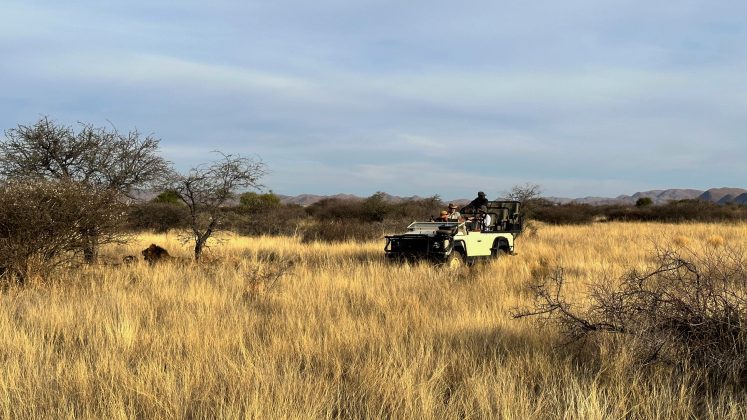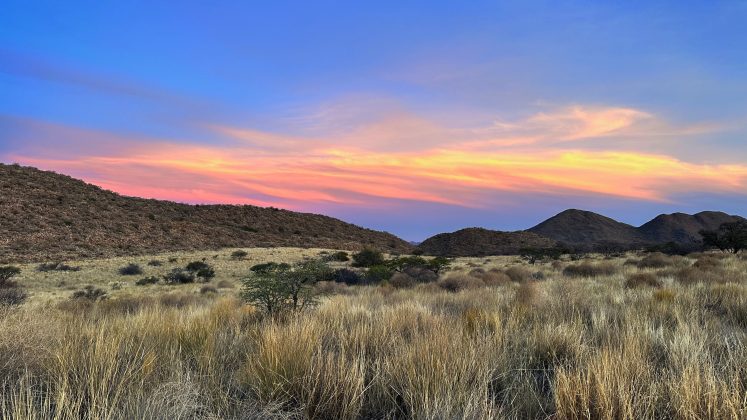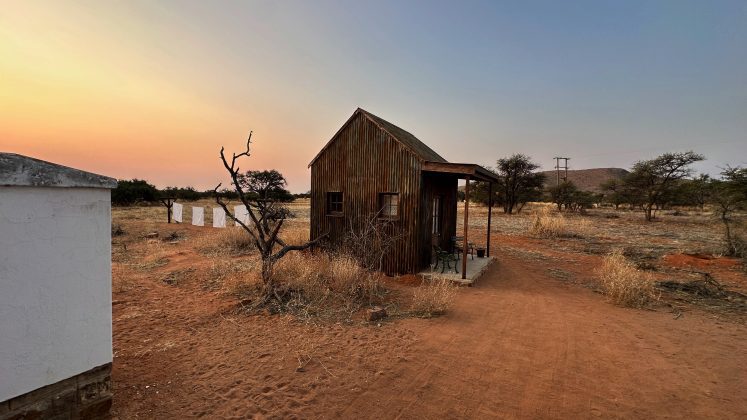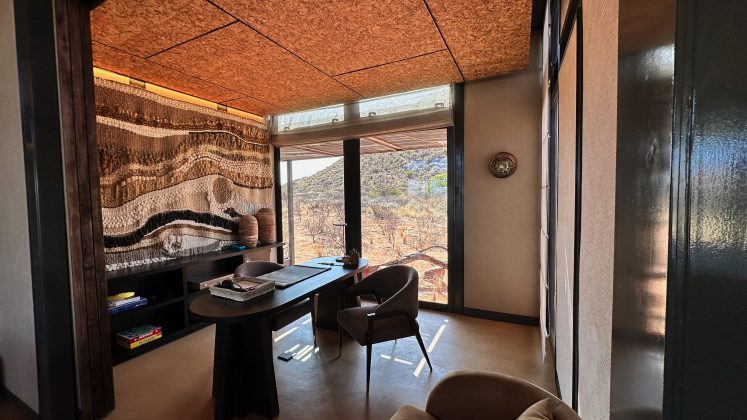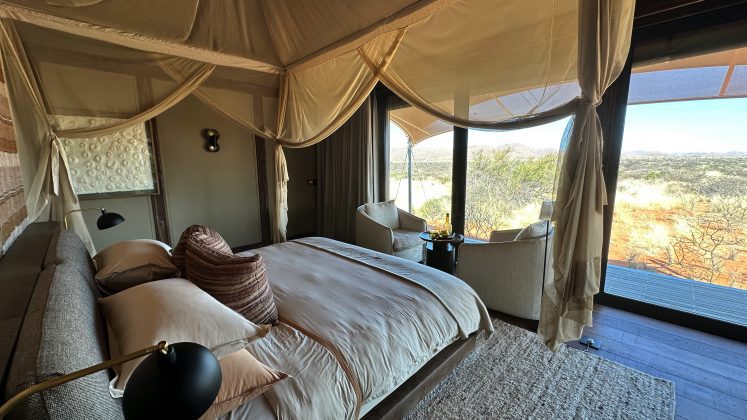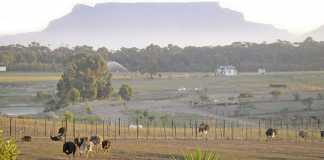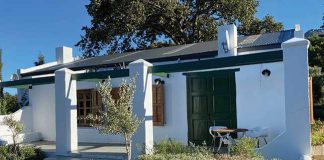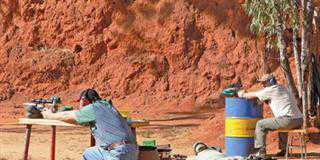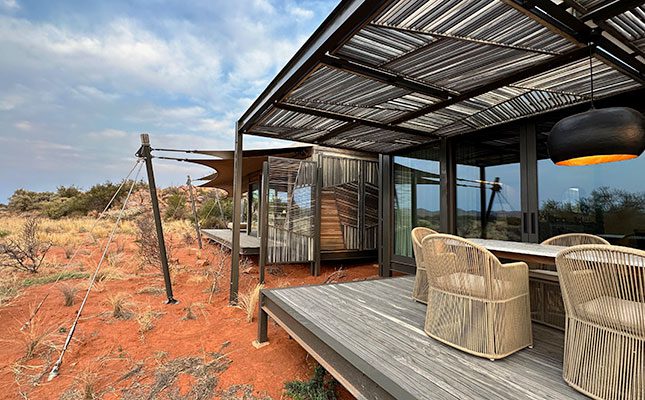
Photo: Brian Berkman
The Oppenheimer family is the force behind Tswalu Kalahari Reserve, a semi-arid southern Kalahari reserve of 114 000ha, the largest privately owned wilderness in South Africa.
The Korannaberg mountains run from north to south while rolling red sand dunes and small hills shape the landscape. Known as the green Kalahari, there are many more species here than further up to the north.
Remote and rugged, the area is so vast that a number of days is required to fully explore it.
When Farmer’s Weekly visited in September, the grasses were golden and the incredibly fine red sands gave way underfoot as if we were walking in an hourglass.
Tswalu Kalahari Reserve may be among the last great wilderness areas where the primary role is to return the land to its natural state and to reintroduce animals that naturally occur there.
You may be lucky, as we were, to see a family of lion feasting on a zebra, its hind legs already chewed off, within the first hour of visiting.
Or, as we were on the second day, lucky to encounter a cheetah mother with her three cubs with an oryx kill.
There are three colonies of meerkats that have been habituated by a team dedicated to these charismatic animals so that they are comfortable with guests on foot near their burrows. Experiencing this was a highlight of our stay.
Guides are essential
Because of the vastness, tracker guides are essentially important. Fezile Mandleni, with field guide Ryan Veale, led us in the wilderness.
Tswalu Kalahari Reserve offers an on-site Tracker Academy, which offers a formal qualification to youth from disadvantaged backgrounds, combining indigenous tracking skills with modern conservation techniques to advance tracking as a profession.
A photograph displayed in our sumptuous room behind the bed, taken 50 years ago, reveals the then landscape as ravaged by farming and neglect.
With it is a note from Nicky Oppenheimer that sets out Tswalu’s conservation goals and the role that the very few guests who are able to visit, make to its sustainability.
Accommodation is limited to a maximum of 40 people. With a staff team of around 280 to care for the land and hospitality services, this is as personalised an experience as you are likely to find.
And, if you are staying at Loapi, the July 2023-opened six ‘tented’ accommodations, you have exclusive use of vehicle, guide, tracker, homathi (the name given to the caregivers of the community), and a chef.
Life at Loapi is entirely bespoke. Want to spend the whole day sunning yourself on the various decks and in the water-wise pool with free-flowing cocktails, fine wines and feast all day?
This is offered in the fully inclusive package. Want to spend the whole day or night out exploring with field researchers? That too is possible.
Perhaps a lavish bush picnic, sat in comfy chairs under a shading tree watching the comings and goings at a water source?
What about lavish sundowners from the Landy converted into a cocktail bar for this very purpose? This, and pretty much all you can dream up, is offered too.
Studying nature
If your interest is deep and you want to interact with the researchers at the Tswalu Foundation studying, among other things, the significant role the pangolin (the second-most trafficked mammal in the world) plays in the ecology of the area, the sociable weaver birds and their impact, or puff adders and how they might be able to predict climate change, you are encouraged do so with the PhD and master’s candidates there.
You will see many antelope, great and small, and the iconic oryx that has become the postcard image of the Kalahari.
And you may encounter game en masse, vast herds of eland, wildebeest, zebra and oryx.
Our team set out on foot to find black rhino in the long grass. We were rewarded with a beautiful rhino female and her young offspring.
With the exception of elephants, you can find the traditional big five here.
More important plusses is that the Tswalu clinic provides free medical care for anyone within 100km, and the reserve’s primary source of produce is from local suppliers.
Fine dining
The acclaimed fine-dining restaurant, Klein JAN at Tswalu, has highlighted local ingredients and wines to a global audience, and will be an experience to remember.
But, especially when you stay at Loapi, designed by Cape Town architectural firm GAPP Architects, what you really get is space.
The physical built environment has such a light footprint that, if needs be, it could be carted away and installed elsewhere with very minimal environmental impact.
And, like the meaning of the name Loapi (the space below the clouds), the raised platform of your 350m2 dwelling (or 450m2 if you are in a two-bedroomed house for a family travelling together) and the insulated tented roof structure efficiently maintain temperature.
As large as the accommodations are, they are minuscule in the context of the environment around you.
With the Korannaberg mountains behind you and open space as far as the eye can see ahead, this is big-sky country that allows you to fully exhale and inhale restorative peace.
In case you think having a staff team at hand will hamper your sense of privacy, the pantry and prep-kitchen is accessed from an outside door, while the inside door can be closed to your area of the house.
Your team can be reached by bell or WhatsApp via the available Wi-Fi network. Your entire experience here is tailored to you. Want your chef to braai for you? Done.
Want all the food and fire prepped so you can braai yourself if you want to?
Everything at Loapi is just as you want it. Gluten-free, sugar-free, vegan and other dietary requirements are spectacularly and fully catered to.
Other Tswalu accommodations include Motse, the stone and thatched houses around communal dining and pool areas, and the exclusive-use Tarkuni homestead for a larger family or a small group.
Reaching Tswalu is as easy as checking into the private airport in Cape Town or Johannesburg and in two-or-so-hours, landing on Tswalu’s airstrip in the luxury of a eight-seater Beechcraft.
No other experience, here or abroad, will be quite like a visit to Tswalu, especially when you consider that they and other members of The Long Run conservation network are protecting the wilderness for future generations, and by your support, you are too.
Tswalu Kalahari Reserve has been included for the first time in the annual Condé Nast Traveler Readers’ Choice Awards, placing 12th in the Best Resorts in South Africa category for 2023.
Visit tswalu.com.

